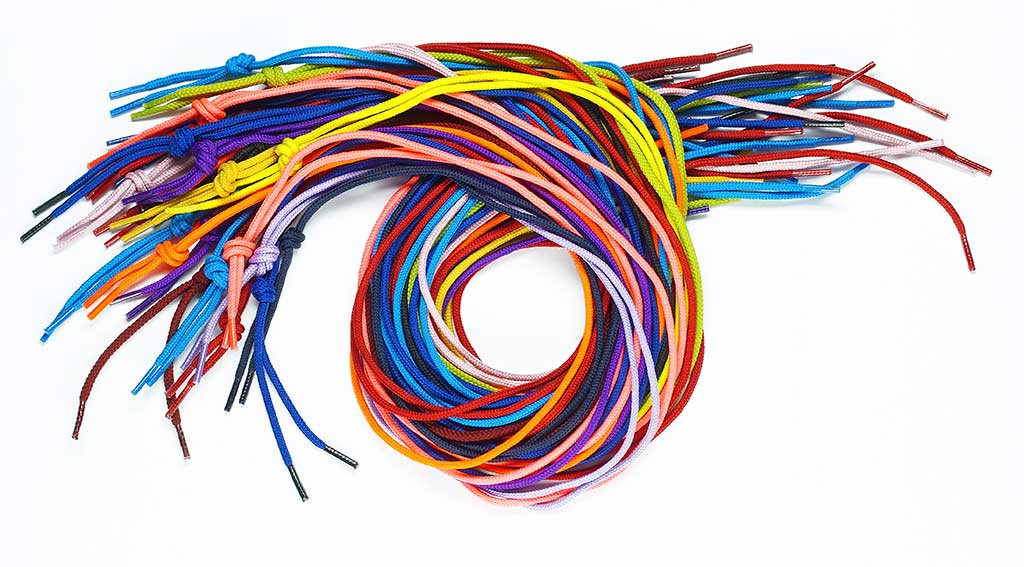How are shoelaces made?

Shoelaces, these often overlooked but essential elements, are based on a rich and evolved know-how. Behind their apparent simplicity lies a world of fascinating materials and manufacturing techniques. From the selection of natural fibres and synthetic materials to the use of mixed compositions, every step is crucial to ensuring their robustness and aesthetic appeal.
We will passionately reveal the manufacturing process for laces, going through the spinning and weaving, then the colouring and treatment of these indispensable companions to your shoes, to finally tackle cutting and finishing. And what about recent innovations in this field? Eco-friendly and sustainable laces, advanced manufacturing technologies and new designs and functionalities will bring a touch of modernity to this age-old world. what is a shoelace: our complete guide.

What materials are used to make shoelaces?
Laces, those little cords essential for keeping your shoes snug, can be made from a variety of materials. Each offers unique characteristics in terms of durability, elasticity and aesthetics. Let's take a look at the different types of materials used to make laces.
Natural fibres
Natural fibres such as cotton and leather are prized for their comfort and authentic look. Cotton laces, for example, are soft to the touch and absorb moisture well, making them ideal for everyday use. Leather, meanwhile, lends a touch of timeless elegance to your shoes, while also being robust and durable.
Synthetic materials
Synthetic materials such as polyester and nylon are commonly used for their tough and flexible properties. Polyester is particularly popular for its tear resistance and low cost. Nylon, which is more elastic, is often chosen for sporting activities thanks to its ability to withstand repeated strain without deteriorating.
Mixed compositions
To combine the advantages of natural and synthetic fibres, certain mixed compositions are used. For example:
- cotton-polyester: offering a balance between natural comfort and increased resistance;
- nylon-leather: ideal for those looking for a refined aesthetic with the robustness of nylon.
These blends make it possible to create versatile interlinings tailored to a variety of specific requirements.
Have you ever thought about what type of material would best suit your needs? Whether you're a fan of classic style or a seasoned sportsman, there's a perfect lace that will meet your expectations!
The shoelace manufacturing process
The making of shoelaces is a meticulous art, combining tradition and innovation to create products that are both functional and aesthetically pleasing. Have you ever wondered what materials are used to make shoelaces? Let's delve into the heart of this fascinating process.
Spinning and weaving
It all starts at the spinning stage, where the chosen fibres - whether natural like cotton or synthetic like polyester - are transformed into strong, resistant yarns. These threads then go through the weaving or knitting stage, a crucial phase that determines the final strength and texture of the lace. Imagine a patient craftsman at his loom, paying attention to every detail to ensure perfect thread tension.
Colouring and treatment
Once woven, the laces come to life through colouring. The dyes used can vary according to need, from bright colours for sporty trainers to more subdued shades for dress shoes. The treatment is not just aesthetic; it can include special finishes to improve water or UV resistance. For example, laces for hiking boots often benefit from a water-repellent treatment to withstand all weathers.
Cutting and finishing
The final stage consists of cutting and finishing. Rolls of coloured fabric are precision-cut to specific lengths to suit different types of footwear - from elegant ankle boots to casual sneakers. The ends of the laces, called ‘aglets’, are then attached. These small plastic or metal pieces prevent the cord from fraying, while making it easier to pass through the eyelets.
Thus concludes the journey of a simple cord to become an indispensable part of your everyday life. Every step of the process demonstrates an unrivalled expertise and meticulous attention to detail that makes all the difference between an ordinary shoelace and a true masterpiece of craftsmanship.
What are the recent innovations in shoelace manufacturing?
Laces, those seemingly simple cords, have undergone a real revolution thanks to technological advances and environmental awareness. Have you ever wondered how a simple accessory can combine innovation and sustainability? Let's delve into this fascinating world together.
Ecological and sustainable shoelaces
Nowadays, more and more manufacturers are turning to environmentally-friendly materials to produce shoelaces. We are seeing the emergence of models made from natural fibres such as organic cotton or hemp. Not only are these materials extremely hard-wearing, they also have a low environmental impact. Imagine wearing shoes whose laces help to preserve our planet! Isn't that rewarding?
Advanced manufacturing technologies
Innovation doesn't stop at the materials used. Manufacturing techniques are also evolving to offer ever-better products. For example, the use of 3D knitting means that laces can be created without seams, reducing weak points and increasing durability. In addition, some companies are now incorporating anti-microbial technologies into their manufacturing processes, ensuring laces stay fresh and hygienic for longer.
New designs and features
Finally, the design of laces is also seeing its fair share of innovations. From reflective designs for night-time sportsmen to elastic laces that make it easier to put on quickly, there are now a multitude of options to meet a variety of specific needs. For those looking to add a touch of originality to their outfit, printed patterns and vibrant colours have become a must.
These innovations show that even something as everyday as the shoelace can be rethought to better meet modern expectations while respecting our environment.
We recommend these other pages:
